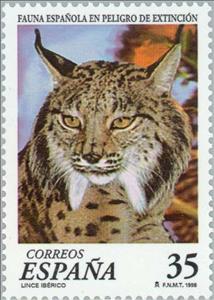Stamp: Iberian Lynx (Lynx pardina) (Spain 1998)
Iberian Lynx (Lynx pardina) (Spain 1998)
05 February (Spain ) within release Spanish fauna endangered goes into circulation Stamp Iberian Lynx (Lynx pardina) face value 35 Spanish peseta
| Stamp Iberian Lynx (Lynx pardina) in catalogues | |
|---|---|
| Michel: | Mi:ES 3368 |
| Stamp Number: | Sn:ES 2928 |
| Yvert et Tellier: | Yt:ES 3103 |
| Unificato: | Un:ES 3102 |
Stamp is vertical format.
Endangered fauna: Lynx pardinaStamp Iberian Lynx (Lynx pardina) it reflects the thematic directions:
Mammals are any vertebrates within the class Mammalia (/məˈmeɪli.ə/ from Latin mamma "breast"), a clade of endothermic amniotes distinguished from reptiles (including birds) by the possession of a neocortex (a region of the brain), hair, three middle ear bones and mammary glands. All female mammals nurse their young with milk, secreted from the mammary glands. Mammals include the largest animals on the planet, the great whales. The basic body type is a terrestrial quadruped, but some mammals are adapted for life at sea, in the air, in trees, underground or on two legs. The largest group of mammals, the placentals, have a placenta, which enables the feeding of the fetus during gestation. Mammals range in size from the 30–40 mm (1.2–1.6 in) bumblebee bat to the 30-meter (98 ft) blue whale. With the exception of the five species of monotreme (egg-laying mammals), all modern mammals give birth to live young. Most mammals, including the six most species-rich orders, belong to the placental group. The largest orders are the rodents, bats and Soricomorpha (shrews and allies). The next three biggest orders, depending on the biological classification scheme used, are the Primates (apes and monkeys), the Cetartiodactyla (whales and even-toed ungulates), and the Carnivora (cats, dogs, seals, and allies).
Animals are multicellular, eukaryotic organisms of the kingdom Animalia (also called Metazoa). All animals are motile, meaning they can move spontaneously and independently, at some point in their lives. Their body plan eventually becomes fixed as they develop, although some undergo a process of metamorphosis later on in their lives. All animals are heterotrophs: they must ingest other organisms or their products for sustenance.


